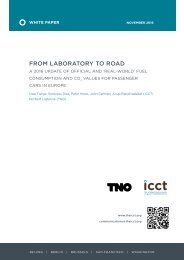Vol 55
Vol 55
Vol 55
- No tags were found...
You also want an ePaper? Increase the reach of your titles
YUMPU automatically turns print PDFs into web optimized ePapers that Google loves.
So, what have you done for us lately? 5It was only in 1960 that the first regular reports'contributed by staff of the Guildhall Museum'(notably Peter Marsden) began to appear. Butan increased pace of archaeological discoveryand greater public interest can be seen in theSociety's lecture programme, which in 1968included speakers like Glyn Daniel, SheppardFrere and Rupert Bruce-Mitford.The 1960s saw the establishment of theSociety's special committees. The HistoricBuildings Preservation Committee (now HistoricBuildings and Conservation Committee) beganthe still essential task of considering the impactof planned developments on the built heritageof London and responding with advice onparticular cases. The Archaeological ResearchCommittee organised its first annual conferencein ] 964; the Local History Committee — thenow integrated Middlesex Local HistoryCouncil — soon followed suit. Held on Saturdayafternoons in the Livery Hall at Guildhall, theseevents included tea (with dainty iced cakes). Atthe archaeological conference of 1968, memberspaid 5s (25p), non-members 7s 6d (37.5p) andheard reports on excavations by Roy Canham,Nick Farrant, Harvey Sheldon, John Kent andPeter Marsden. (The price had risen to 75pby 1976, the last year that the archaeologicalconference was held at Guildhall.) 1967 saw thefirst issue of the Society's Newsletter (originallyNews-letter) replacing an earlier Bulletin. From thebeginning this included notices of the activities ofour affiliated societies, still an essential elementof the Newsletter. But that LAMAS was no longeralone in the field was emphasised in 1968 when anew type of archaeological magazine for London,the London Archaeologist, made its appearance— thanks to the enthusiasm of Nick Farrant(Fuentes) — and Londoners could find out aboutrecent and current excavations without joining asociety!In many ways the Guildhall Museum'sexcavations at Baynard's Castle in 1972 markeda turning point, with wider recognition ofthe special nature and problems of 'rescue'archaeology. Our Society contributed to thefirst group of published surveys of London'sarchaeological knowledge and potential in itsfirst Special Paper The Archaeology of the LondonArea: Current Knoxvledge and Problems in 1976,alongside Rescue's The Future of London's Pastand the joint Museum of London/Departmentof the Environment/Greater London Councilpublication Time on Our Side? In 1975 the Societytook a more active role as local units wereestablished or reconstituted to carry out rescueexcavations in London, with the formation ofthe Inner London (North) Archaeological Unit— the '(North)' seems to have become optional.This was managed by a committee of LAMASrepresentatives together with representativesof seven inner London boroughs which,with the Department of the Environment,provided funding. In the next few years theunit investigated over a hundred sites, rangingfrom Westminster Abbey to a sheet iron sentrybox at the West India Dock, as well as publishingbooklets on the archaeology of the boroughsfor which the unit was responsible. For the firsttime the Society found itself in the position ofemploying full-time archaeological staff. Onlythe hard work of the then Honorary Treasurer,Allan Tribe, made this possible. It was, I suspect,with some relief that after long campaigning towin central funding from the Greater LondonCouncil (little did we know) we saw 'our'archaeological unit merge with others in theMuseum of London's Department of GreaterLondon Archaeology in 1983.LAMAS had long had informal links with staff ofthe Guildhall Museum and the London Museum— members of the museums' staff served in apersonal capacity on the Society's committees,and Roy Canham and his successor AlisonLaws, the London Museum's archaeologists,had organised the annual archaeologicalconferences. With the establishment of thenew Museum of London in 1976 these linkswere formalised, by an advantageous agreementmade with the Museum's Board of Governors(although the suggestion that this madethe Society a wholly-owned subsidiary of theMuseum is one that should be strongly denied!).The Society's library and its meetings movedfrom the Bishopsgate Institute, which had beenthe Society's headquarters since 1911, to thenew Museum of London building in LondonWall. The archaeological conference in 1977was one of the first events to be held in theMuseum's Lecture Theatre, and took the nowfamiliar form of a full-day meeting. The twoannual conferences remain a major feature ofour programme — the local history conferencein particular, with displays by our AffiliatedSocieties, is very popular.For some while after 1976, with myself asHonorary Secretary and the late Hugh Chapmanas Honorary Archaeological Editor, much of the



